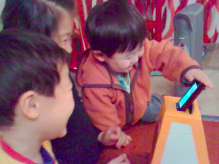At CHI 2013, I attended and helped organize a workshop on Designing for Diverse Families. I’ve been meaning to blog about it for the past two months and recently reconnecting with one of the other organizers has given me the push that I needed. I want to tell you about one discussion that we are hoping to turn into an actual project. I also want to invite both workshop participants and readers who find this to be a compelling idea to potentially join in on this project.
The goal of the workshop was to better understand our own assumptions about what constitutes a “family,” understand the gaps in our own work, and see how we can be more inclusive as a community. The variety of projects presented really highlighted how different families can be in terms of structure, practices, values, and culture. While this diversity can make it very difficult to design for families, it is also an incredible resource. At a time when many parents experience a great deal of anxiety about “parenting right” and face conflicting seemingly authoritative sources on doing it this way or that way, it can be valuable to show that there are many ways to be a parent. Things that are assumed to be true in one culture, can be unheard of in another, but nonetheless children grow up and succeed. My favorite idea that came out this workshop is that getting a perspective from a different culture on specific parenting questions can be of benefit to many families. Basically, we want a parent to be able to ask “how do other families do this?” when faced with everyday worries such as when to introduce particular foods, how to sleep train a child, how to deal with an unruly teenager, etc. Presenting these answers in the context of their originating geography can help bring home the idea that there is no single right way of dealing with most of these questions, but rather many approaches that can be successful.
So, a few of us would actually like to make this happen! Here’s the basic sketch of a plan:
- We populate the initial list of questions and answers using Yahoo answers
- We continue getting answers to common questions by selectively using Mechanical Turk, tracking the geographic locations of the Turkers
- We allow users to ask questions of the community and see a selection of answers from different parts of the world displayed on a map
- Users are encouraged to give their own answer to another question when they see answers to their own
Obviously, it’s fairly rough at this stage, which is why I’m reaching out to y’all. So for the parents out there, would this be useful for you? For the builders out there, would you be interested in getting involved in making this happen? For the researchers out there, would you be interested in getting on board or just giving advice? If you are interested in being a co-investigator, please fill out this survey to let us know what you’d like to do and we can start getting a plan together!


